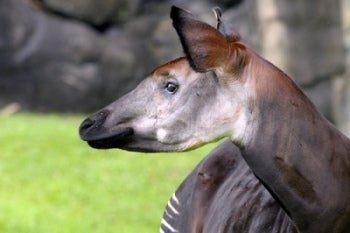
La página que intenta visitar sólo está disponible en inglés. ¡Disculpa!
The page you are about to visit is currently only available in English. Sorry!


A captive Okapi at a breeding center in Florida. Photo: Valerie / (CC BY-NC-ND 2.0)
A retaliatory attack on an African wildlife reserve has left 19 dead, including six people who devoted their lives to protecting endangered species.
In the early morning on Sunday, June 24th, mai mai rebels raided the Okapi Wildlife Reserve headquarters, located in the Democratic Republic of the Congo. After burning buildings and looting supplies they then attacked the nearby village of Epulu.
By June 26th the Congolese army and UN troops took control of Epulu and the reserve headquarters, but the welfare of the staff and the captive horse-like okapi remained unknown until the 28th. Casualties include two rangers, the wife of a ranger, an immigration worker, two village residents, and 13 okapi. About 100 people work at the headquarters, and many escaped by hiding in the surrounding forest.
Damage to the reserve headquarters was severe. All buildings were either burned or damaged, and the rebels stole or destroyed motorized equipment, computers, printers, phones, food stores, and medical supplies.
The reserve is run jointly by the Okapi Conservation Project (OCP) and the Institute in Congo for the Conservation of Nature (ICCN), the government agency responsible for protecting native species.
The mai mai rebels are not a political group but a local gang made up of elephant poachers and illegal miners, according to OCP representative John Lukas. He also states the poachers were “seeking revenge” on the ICCN for their recent efforts to stop elephant poaching and illegal gold mining within the reserve. Lukas suspects that the OCP was targeted for aiding the ICCN.
The Okapi Wildlife Reserve was established in 1992 to protect the okapi and its habitat in the Ituri Forest. Covering 5,289 square miles of lowland rainforest, the reserve is home to about 5,000 okapi and other vulnerable species, including elephants, leopards, 13 different primates, and forest buffalo.
Okapis are large mammals that look like a mix between a giraffe and a zebra. Their most striking feature is their coat, which is chocolate brown along the neck and body, but striped like a zebra along the front and hind legs. Despite sharing the zebra’s stripes, okapis are actually more closely related to giraffes. They inhabit Africa’s rainforests, stripping leaves from the vegetation with their long, blue tongues.
The International Union for the Conservation of Nature (IUCN) lists the okapi as “near threatened.” There are an estimated 10,000 – 35,000 okapi in the wild, but they are threatened by poaching, development, logging, and an expanding human population. Unlike other African mammals, okapis are entirely restricted to the Congo’s rainforests.
The Okapi Conservation Projects funds the ICCN government staff of rangers that protect the reserve and its wildlife. The biggest threats to the reserve are poachers, illegal loggers, and illegal miners. Bushmeat hunting is also a serious problem. People in the Congo Basin eat more meat than people from industrialized northern countries, and 60-80% of the meat they eat comes from wildlife, according to the World Wildlife Fund.
This attack is a grim reminder of how, at least in some places, conservation work can actually be dangerous, both to humans and the creatures they protect.
Related Links:
Cracking Down on Poaching of Endangered Species, CSI-Style
Update: One California Condor Shot by Poachers Dies; the Other Released